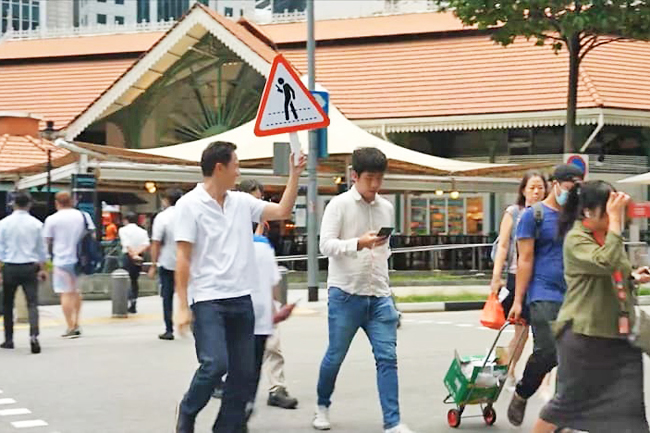CNA – Zombies may be fictional, but distracted walkers are all too real. With necks bent, eyes lowered and ears plugged, they navigate our streets with devices in hand – you’ve either seen them or are them.
As early as 2015, a survey conducted by Nanyang Technological University students found that 93 per cent of 419 youths admitted to “multi-tasking while walking”, which led to 598 reported accidents among them. These included minor falls, collisions with other pedestrians and traffic accidents.
Ironically, 84 per cent confessed that they were precognisant of the dangers of distracted walking.
There are various reasons why distracted walkers are seemingly going against their better judgement.
Some pedestrians caught on camera recently, on the programme Talking Point, were scrolling through social media pages like Instagram and TikTok, text-messaging or playing mobile games.
These activities were not urgent, one of the passers-by acknowledged.
“Sometimes you feel so bored with stuff around you, so it just becomes a natural instinct.”
Normalising such instincts, however, can lead to tragic consequences.




In 2022, Mohamad Yusman Sahadan, 52, died after being struck by a car while jaywalking at the junction of Sims Avenue and Aljunied Road. A coroner’s inquiry found that he was distracted by his phone and unable to react to oncoming traffic.
But distracted walking not only reduces the awareness of our surroundings. Experts said the habit can also affect our body and brain, from pace and posture to cognitive capacity.
WHAT IT DOES TO YOU
The hallmark of distracted walkers is evident in the way they walk – specifically their slower pace than normal.
The moment our eyes lock on our smartphone screens, our vision narrows, and the brain compensates by shortening our steps, said Navdeep Vij Singh, chief digital neuroscientist at neuroscience clinic Neurowyzr. This slows us down and, in many cases, creates a human traffic jam.
Over time, distracted walkers may also experience “text neck”, a condition that affects neck posture due to frequently bending the neck forward.
Research has found that neck muscle activation is approximately 21 to 42 per cent higher when using a phone while walking, compared to sitting or standing. This can lead to neck pain, headaches and other issues affecting our shoulder muscles.
Furthermore, a 2022 study on text neck syndrome suggested that prolonged mechanical strain on the cervical spine – the neck region of our backbone – may lead to a sense of imbalance, impaired movement co-ordination and disrupted functionality in the respiratory, circulatory, digestive and nervous systems.
There is also “a big drop-off” in brain function as the brain can become overburdened with distractions and reach its cognitive limit, warned neurosurgeon Prem Pillay,
For instance, when you walk and text simultaneously, the brain’s motor cortex must double down on both activities.
“That’s a lot of load on the motor cortex,” he said.
And when brain performance drops, “(it’s) very likely, if you’re doing something dangerous like walking across a road with busy traffic, that you might have an accident”.
SHOULD IT BE MADE ILLEGAL?
Singapore is not alone in finding distracted walking a hard nut to crack. Worldwide, “petextrians” have taken over the streets, prompting new laws to curb the habit.
In 2017, Honolulu became the first major city in the United States to fine pedestrians – up to USD99 (SGD133) – for crossing a street or highway while looking at their electronic devices.
Smaller cities in Idaho and California have also outlawed texting while crossing the street and even banned pedestrians from being on the phone while crossing.
Closer to home, Baguio City in the Philippines revised its laws against distracted walking last September; offenders now face warnings or 10 days of community service.
Singapore has no laws against such behaviour.
But should authorities consider the possibility?
Singapore University of Social Sciences senior lecturer Maria Cecilia Rojas Lopez, whose research interests include transport planning and urban management, pointed out the potential challenge of defining the criteria for distracted walking within a legal framework.
For example, questions regarding the amount of phone use deemed distracting, and which exemptions should be permitted, may arise.
Additionally, such a law would require “a lot of manpower” to enforce, with many pedestrians already accustomed to walking while using their phones.
WHAT MEASURES CAN SINGAPORE TAKE?
Legislation aside, efforts to curb distracted walking have been explored before.
In 2017, LED strips were installed on pavements at four pedestrian crossings along Orchard Road, Victoria Street, St Andrew’s Road and Bencoolen Road.
These coloured light strips, synchronised with the traffic signals, were aimed at helping pedestrians, particularly those looking at their smartphones, cross the road safely. This initiative did not yield significant results, however, and concluded once the trial period was over.
Similarly, in 2019, large yellow stickers bearing the words “Look Up” and a crossed-out mobile phone symbol were affixed on pavements at the junction near Ang Mo Kio MRT station and at its entrance.
Initially, residents were puzzled as some considered it common sense, while others praised the effort.
Former Member of Parliament (Ang Mo Kio GRC) Ang Hin Kee said that while the move did raise road safety awareness, people became less attentive over time as they became used to the presence of the stickers.
Once the two-year campaign wrapped up, the Land Transport Authority removed the stickers.
Despite the short-term nature of these initiatives, hope endures. Some Talking Point viewers have offered their own suggestions on how to address the prevalence of distracted walking.
One proposal was to implement audio signals at busy crossings, similar to the announcement system used in MRT stations, instead of relying solely on visual cues.
Another idea involved developing an app capable of detecting when individuals are walking and alerting them to refrain from using their phones.
Drawing inspiration from anti-theft shopping trolleys in the United States that automatically lock when leaving the store’s car park, one viewer suggested implementing a software-lock feature at road junctions.
Another suggestion was to create “mobile phone rest stops” in busy streets and shopping centres, where pedestrians who must use their phones can do so safely and considerately.
According to Lopez, the most reliable solution still lies in education – in encouraging people to be mindful of their actions in the street and consider how their behaviour may impact others. – Faith Leong & Eric Teo






